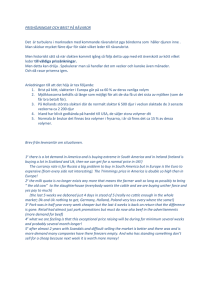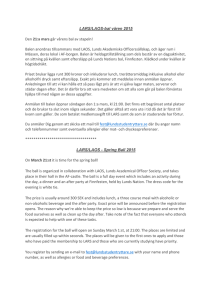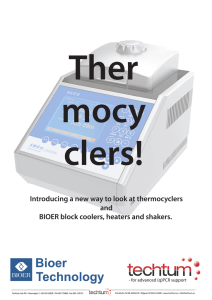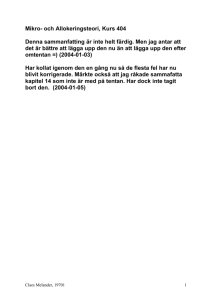Open district heating
advertisement
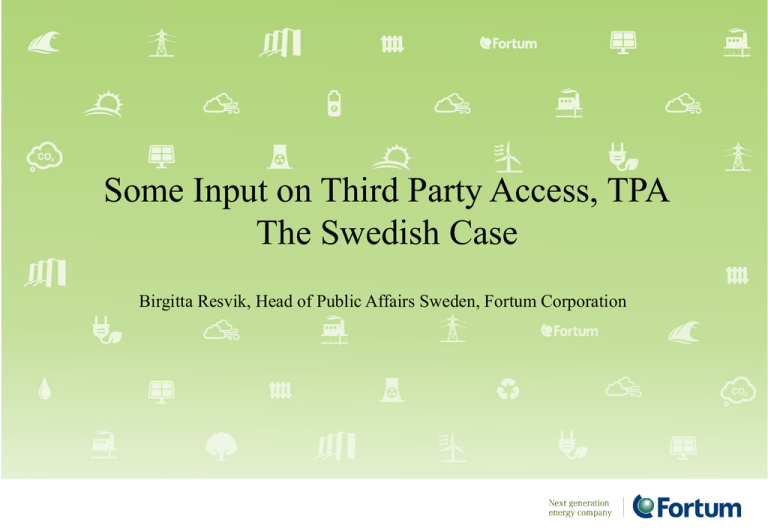
Some Input on Third Party Access, TPA The Swedish Case Birgitta Resvik, Head of Public Affairs Sweden, Fortum Corporation Fortum Värme’s DH System in Stockholm • DHC and some gas • Turnover approx. 800 MEUR • ROCE: 6,9 % • 5 main production sites • 2 x 1200 km of nets • 8 TWh Heat • 2 TWh Electricity • 80 % renewables and residuals Background TPA in the public debate for several years • 2004–2005 – Birgersson’s Inquiry • Recommendation: Don’t go for TPA • Government decision: OK, we won’t • Heavy stakeholders’ reaction: Oh, no! • Government decision: Investigate again • 2009–2011 – Nygårds’s Inquiry • Recommendation: Go for TPA • Heavy stakeholders: Oh, no! • Gov. decision: Ok, we won’t … but let’s investigate some more … Swedish DH Law • DH enterprises are to be managed in a commercial manner (implying that cost plus pricing is not ok, and that municipal subsidies are not ok, and that DH business should not be indirectly or directly subsidised by zoning policies, or supported in any other way that is not technically neutral) • DH enterprises are to be managed separately from other businesses (i.e. electricity distribution and/or electricity retail businesses), and thus accounted for separately • DH enterprises may include CHP, and the revenues from electricity sales is seen as from a by-product, thus diminishing costs for heat and/or steam production • Comprehensive rulings on transparency in pricing and accounting • Governmental mediation committee, without right to impose sanctions or to rule in dispute – not surprisingly deemed toothless by all parties Fortum Värme Pricing Policy • § 1. Alternative Based Pricing FV DH product should always over time be competitive towards • § 2. Non Discriminatory Pricing Equal costumers – in terms of size and profile – to face equal prices, regardless of access to alternative solution of geographical situation within the DH system • § 3. Transparent Pricing DH price structures and principles for future adjustment are made publically and easily available TPA – issues to scrutinise Political Aspects • At least four areas: energy related, social (i.e. energy poverty), environmental, economical Historical Aspects • There is always a point of departure Legal Aspects • There is always a legal context to weigh in Technical Aspects • O&M, responsibility, surveillance, etc. Economical aspects • Theoretical approach – equity functions, utility curves, S/Danalysis, WACC, etc. TPA – The Proposal Put Forward By The Inquiry A two step approach • “Phase 1” – same regime for everybody, no exceptions, “day 1” • Formally not legal, but economic and de facto functional unbundling of DH distribution from all other DH business (in practice, this would mean an a legal unbundling as well, in order to handle regulated net fees) • DH Network Company also System Operator • Outright price regulation of DH Distribution (same model as for electricity distribution) • “Phase 2” to be activated if someone “challenges the incumbent” and wants to connect to the distribution system • The idea was that the mere threat of challenges would counteract “aggressive” pricing by the incumbent (since competition is real, the main result would be less investments rather than higher prices) ”PHASE 2” – Full TPA Galore SYSTEMOPERATÖR Nätintressenter AB SYSTEMANSVARSMARKNADEN Systemansvarsavtal? SYSTEMREGLERING Reserveffektsavtal? Intressentavtal? Spetseffektsavtal? Driftoptimeringsavtal? FJÄRRVÄRMEPRODUCENT Östvärme Privat AB SPETSEFFEKTSMARKNADEN NÄTINNEHAVARE Östnät Privat AB FJÄRRVÄRMEKUND BRF Alfa Spetseffektsavtal? FJÄRRVÄRMEKUND BRF Beta PRISBILDNING? Produktionssamarbetsavtal? ANSLUTNINGSMARKNADEN FJÄRRVÄRMEPRODUCENT Västvärme Kommun AB FJÄRRVÄRMEPRODUCENT Bruksrestvärme AB Nätsamverkansavtal? DISTRIBUTIONSMARKNADEN Distributionsavtal FJÄRRVÄRMEKUND Åsa konsument Nätanslutningsavtal Nätavgiftsavtal? PRODUCENTMARKNADEN Produktionsavtal KUNDMARKNADEN NÄTINNEHAVARE Västnät Kommun AB Fjärrvärmehandelsavtal PRISBILDNING? BALANSMARKNADEN Balansavtal FJÄRRVÄRMEHANDLARE Västhandel Kommun AB FJÄRRVÄRMEKUND Kommunhem AB VÄRMEKUND Lokalindustri AB PRISBILDNING? FJÄRRVÄRMEHANDLARE Östhandel Privat AB FJÄRRVÄRMEKUND Kalle konsument FJÄRRVÄRMEHANDLARE Frihandel AB TPA – The proposal put forward by the enquiry Lots of fundamental questions arose: • Price setting between broker and producer? • Pricing of peak load and of reserve capacity, to be owned by the distributor (!) • Has the distributor full control over its property? E.g., may it dismantle any given section of the network? • What about all the agreements that are necessary, but not commented upon? • How should the brokers go about to handle the “market balance”, for which they are to be responsible? • How to tell the brokers’ market balance responsibility from the system operator’s? • Etc … TPA – issues to scrutinise Return on investments • Claim: “Profitability is in excess of what is motivated by inherent risk” • Refutation: – An actual survey of all Swedish DH companies reached the conclusion that DH suppliers clearly and unambiguously rather suffer from unhealthy low profits – This has somewhat alarmed Government fearing for radically reduce future investments TPA – issues to scrutinise Viable competition • Claim: “There is no real competition” • Refutation: – Substitutes are readily available, even in city cores – Statistics show a growing heat pump industry, as well as a growing pellets burner industry – All new buildings have full freedom of choice, and full competition is at hand (few argue that), and, combined with the “equal treatment principle”, this mean that all costumers enjoy the benefits of competition TPA – issues to scrutinise • DH prices • Claim: “DH suppliers abuse their dominant market position, and set monopolistic prices – that is, too high prices, and particularly in Stockholm” • Refutation: – This is not true, DH prices continuously competitive – New sales to new customers prove the point – Se the following graphs … Fortum Värmes nyförsäljning av fjärrvärme i Storstockholm - årlig inkopplingar av nya leveranspunkter (rensat för förvärv) uttryckt i GWh per år 1980 - 2010 Alternative Pricing in Practice – “IRL” competitiveness 400 350 300 GWh 250 200 150 Fjärrvärmepriset jämfört med alternativen 100 50 Prisutvecklingen för uppvärmning av en bostadsfastighet med 193 MWh fjärrvärmebehov. Källor: oljepris SCB medelpris 12 mån. april 2010, elpris Nordpool prognos spotpris 12 mån. april 2010, pelletspris Agroenergi 3 ton bulk april 2010. DoU- och investeringskostnader Fortums bedömningar. Avskrivningstid 15 år. Real kalkylränta 2,1 procent. 8 2010 2008 2006 2004 2002 2000 1998 1996 1994 1992 1990 1988 1986 1984 1982 1980 193 MWh flerbostadshus – ”Nils Holgersson-huset” – exkl. moms 0 TPA – issues to scrutinise • Trust – that illusive, but all-important factor embedded in “the brand of the market as a whole” • Claim: “you guys are not to be trusted” • Well, how do you refute that? • It’s hard, but maximal transparency and delivery on promises are certainly factors that have to be a part of the solution • Proven competitiveness over time is another • Proven reasonable returns in relation to specific risk • No “lock-up” contracts • Non-discriminatory pricing • A plethora of price models Fortum Värme’s Proposal (Swedish) to the Government • Mekanism för öppna nät för kundtillträde [Mechanism for cooperation w/ customers]”att regeringen på sätt som befinns lämpligt och i samverkan med berörda parter medverkar till utvecklingen av en mekanism för att i öppna nät medge kundtillträdesrätt, syftande till att säkerställa att kunder med egen tekniskt och energimässigt användbar kapacitet ges möjlighet att leverera in värme till fjärrvärmeföretaget på för bägge parter ekonomiskt sunda och affärsmässiga villkor” • Mekanism för öppna nät för producenttillträde [Mechanism for cooperation w/ producers] ”att regeringen på sätt som befinns lämpligt medverkar till utvecklingen av en mekanism för att i öppna nät medge producenttillträdesrätt, syftande till att säkerställa att andra producenter, det vill säga restvärmeleverantörer eller andra fjärrvärmeföretag, med egen tekniskt och energimässigt användbar kapacitet, ges möjlighet att leverera in värme till fjärrvärmeföretaget på för bägge parter ekonomiskt sunda och affärsmässiga villkor” • Mekanism för granskning av prisbildning och prispolicy [Mechanism for price adj. scrutiny] ”att marknadens parter ges möjlighet att fortsätta utvecklingen av frivilliga mekanismer för att öka transparensen i prisbildningen och granska fjärrvärmeföretagens efterlevnad av sina prissättningspolicyer i syfte att stärka kundernas ställning och öka förtroendet för branschen” Decision by Swedish Government after the TPAenquiry • Developments: In March 2012 the Government provided their conclusions on how to proceed on the TPA-issue - taken into consideration answers from more than 120 stakeholders, • The suggestions and arguments are balanced - price regulation of distribution and unbundling of DH companies are put aside, as is the TPA idea in general • The main arguments for abandoning the TPA idea is that Government found that it – (1) drives costs (thus enhancing consumer position), and – (2) won’t work due to the size of the local markets (too small) – (3) there are no unjust return levels in the DH business throughout Sweden Decision by Swedish Government – some new minor investigations • The Gov. conclusions covered also a set of three development areas: – (1) signing a non-discriminatory principle into law, aiming at safeguarding that consumers in a particular category should always face equal prices and conditions, – (2) development of a mechanism for price adjustment testing, – (3) development of two mechanisms for the continuous realisation of the waste heat potentials and potentials for joint ventures in production. • Energy Market Inspectorate and Energy Agency are doing the investigations - Findings and proposals finalised by April 30th, 2013 The market is developing - Open District Heating • We want to develop the future’s district heating together with our customers • We want to create a brand new market for recycled energy in Stockholm through our pilot project • Open District Heating = buying our customer’s waste heat at market price Open District Heating turns waste heat into common gains 19 Who can produce heat at the lowest cost? • Open district heating means that we allow our customers to compete with our own production. • If the customer can deliver heat at a lower cost Fortum will buy it. • Open district heating sets a market price of residual heat based on our production cost. Business models - Open spot market price on heating (”first-rate heating”): - Purchase price depends on outdoor temperature as ”first-rate” district heating is delivered on feed lines. The supplier has an option on delivering and gets paid by delivery at the current price. - Open returned heating price (”second-rate heating”): - Purchase price depends on outdoor temperature as ”second-rate” district heating is delivered on return lines. The supplier has an option on delivering and gets paid by delivery at the current price. - Open residual heating price (”residual heating”): - Purchase price depends on delivery temperature during December-March when ”residual heat” is delivered on district cooling return lines. The supplier has an option on delivering and gets paid by delivery at the current price. 21 Benefits of a liberalised heat market Stockholm case Open district heating • Customers should have the freedom of choice between different alternatives in heat market • Three products for customers to choose from • Competing heat sources such as waste heat should enter heat market on commercial merits • Opened the network for heat from other sources 22

